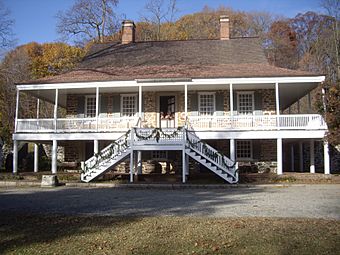Van Cortlandt Manor facts for kids
|
Van Cortlandt Manor
|
|
 |
|
| Location | South Riverside Avenue, Croton-on-Hudson, New York |
|---|---|
| Built | 1665 |
| Architectural style | Dutch-English Colonial |
| NRHP reference No. | 66000579 |
Quick facts for kids Significant dates |
|
| Added to NRHP | October 15, 1966 |
| Designated NHL | November 5, 1961 |
Van Cortlandt Manor is a historic house and property in Croton-on-Hudson, New York. It was built a long time ago, in the 1600s, by the important Van Cortlandt family. This old stone and brick house sits near where the Croton River meets the Hudson River. Today, Van Cortlandt Manor is a museum. It is also a National Historic Landmark, which means it's a very important historical place in the United States.
Contents
History of Van Cortlandt Manor
How the Land Was Acquired
The land for Van Cortlandt Manor was first given to Stephanus Van Cortlandt in 1697. This happened through a "royal charter" from King William III. A royal charter was like a special permission from the king. The land was huge, about 86,000-acre (35,000 ha)! It stretched from the Hudson River all the way to the border of Colony of Connecticut.
Stephanus Van Cortlandt bought much of this land from the Native American tribes. He also bought smaller pieces from other people who had titles to the land. The manor even included a small area on the west side of the Hudson River.
Early Days of the Manor House
The main house, called the Manor House, was built before 1732. However, it wasn't the main home for the family right away. It became the main residence when Stephanus's grandson, Pierre Van Cortlandt, moved there in 1749. At that time, the manor house was on a 1,000-acre (405 ha) part of the original large land grant.
A Busy Community Flourishes
When Pierre Van Cortlandt moved in with his family in 1749, the manor became a very lively place. Pierre created a community that could mostly take care of itself. They had an apple orchard, a dairy farm, and even a place for bees to make honey. There was also a kiln for baking, a tavern for travelers, and shops for carpenters and blacksmiths. A map from 1776 shows that there was even a mill on a stream nearby.
The Manor During the Revolutionary War
As the Revolutionary War began, the manor became a safe place for the family. Pierre Van Cortlandt supported the American colonies. The manor helped the Continental Army by providing food and supplies. Pierre was involved in making laws for the military. His son, Philip, was a soldier in the Continental Army.
Eventually, Pierre and his family had to leave the manor because the war became too dangerous. The British Army attacked the manor, leaving it damaged. After the war, Philip, who became a brigadier general, returned with his sister, Catherine. Together, they worked hard to get the manor back in good shape.
Life After the War and Restoration
After the war, Van Cortlandt Manor became an important stop for people traveling between New York and Albany. The mills were working well again, offering food, supplies, and places to stay for the community and travelers. Pierre and his wife did not return to live at the manor until 1803, once everything was fully working again.
The manor stayed in the Van Cortlandt family for many years. However, in 1945, it was sold to someone outside the family, Otis Taylor. By this time, the property was not as grand as it used to be. Some of the old buildings were even taken down to make room for new things, like a drive-in movie theater.
In 1953, John D. Rockefeller Jr. bought the property. He started working to restore the manor to its former glory. In 1961, Van Cortlandt Manor was officially recognized as a National Historic Landmark. Today, it is one of the historic sites managed by Historic Hudson Valley.
See also
 In Spanish: Mansión Van Cortlandt para niños
In Spanish: Mansión Van Cortlandt para niños



